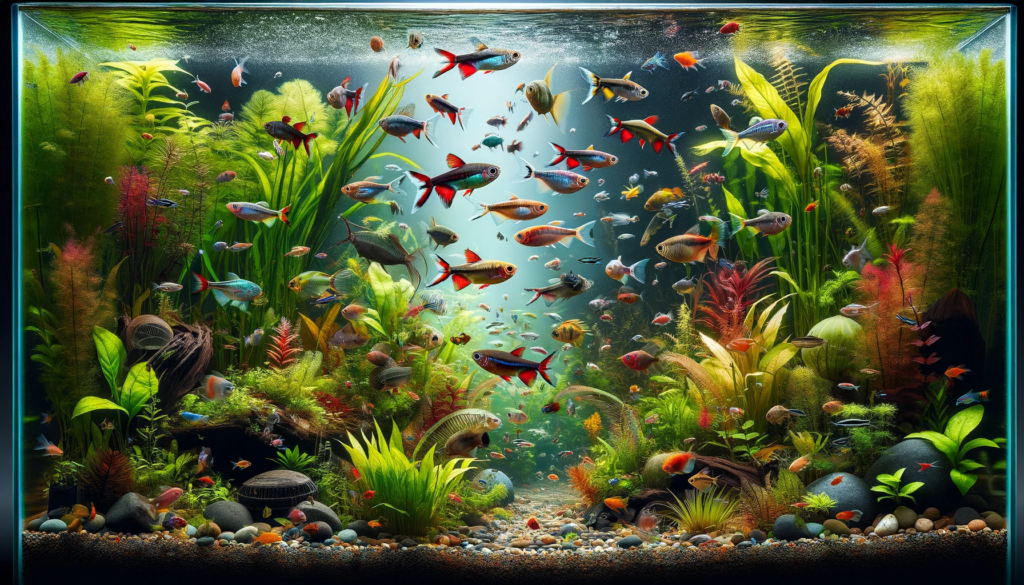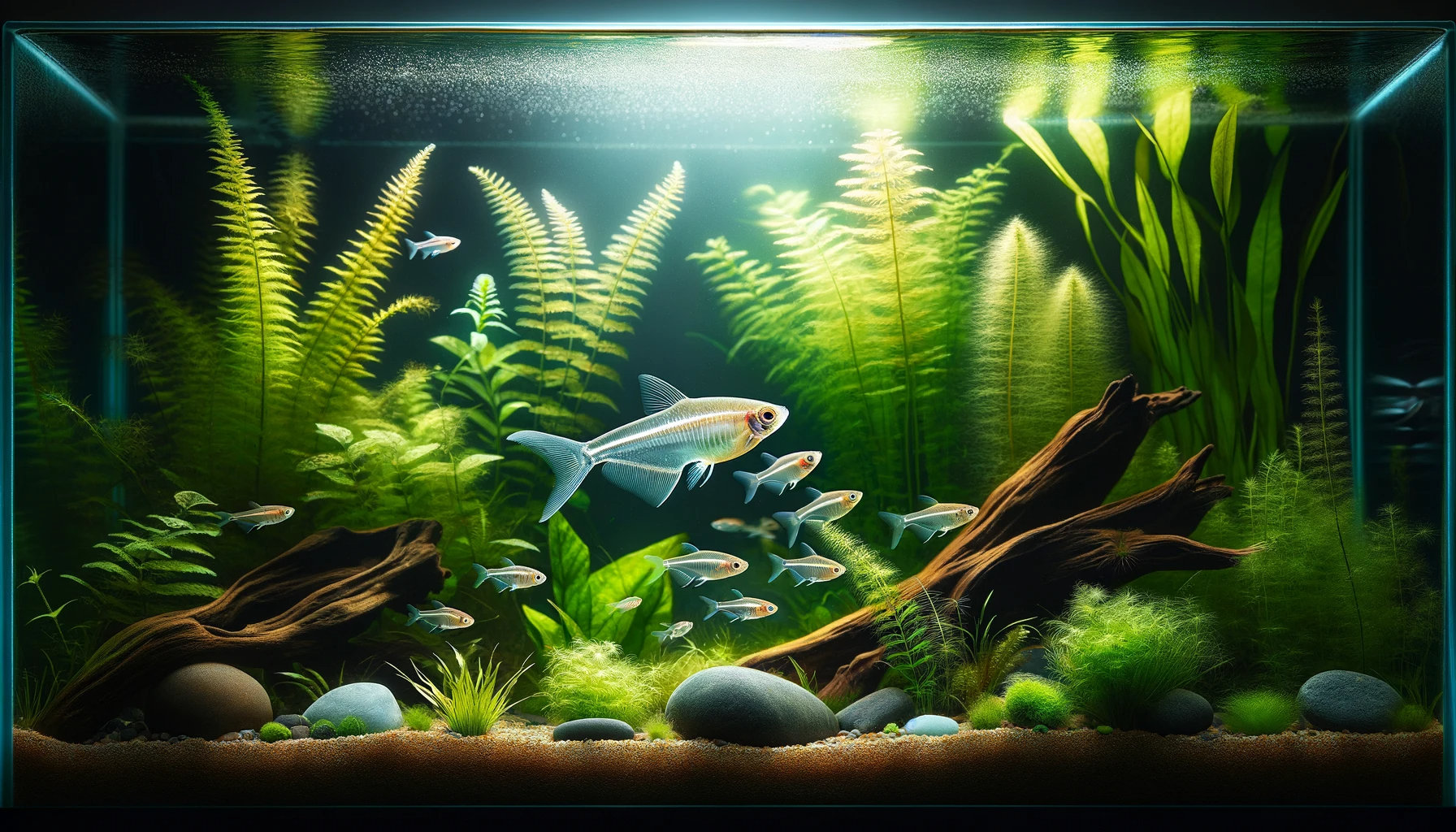The Glass Bloodfin Tetra, also known as the Aphyocharax anisitsi, is a unique species from tetra varieties that is a beautiful adding to community tanks. This guide will provide you with an overview of their appearance, behavior, lifespan, care requirements, diet, tank mates, and breeding.
With the right environment and care, these fish can thrive in any home aquarium. With the right knowledge, you can ensure your Glass Bloodfin Tetras live a long and healthy life.
Overview and Quick facts
The Glass Bloodfin Tetra is an attractive, hardy fish species that is suitable for both novice and experienced aquarists alike. Native to the Amazon Basin in South America, the Glass Bloodfin Tetra is a small, peaceful fish that is ideal for a community tank. It is easily recognizable by its silver body with a black stripe running along the length of its body and a bright red tail fin. In the wild, these fish prefer slow-moving, heavily-vegetated streams and rivers, so replicating this atmosphere in the home aquarium is important.
Glass Bloodfin Tetras are social fish that need to be kept in groups of at least five or more, as they are very active and playful. They will school together, swimming in unison and interacting with each other.
Glass Bloodfin Tetras (Prionobrama filigera) are visually striking freshwater fish native to Ecuador, Colombia, Brazil, and Bolivia1. They are known for their elongated body shape, bright red coloration on their tail and dorsal fins, and translucent or glass-like appearance3. Here are some quick facts about Glass Bloodfin Tetras:
- Size: They can reach an adult size of up to 6 cm (2.4 inches)3.
- Habitat: Glass Bloodfin Tetras are native to the Paraguay and Paraná river basins in South America3.
- Diet: They are omnivorous, consuming a variety of foods in the wild, including flakes, pellets, frozen foods, and live foods such as brine shrimp and bloodworms5.
- Temperament: Glass Bloodfin Tetras are generally peaceful and can be kept with compatible tank mates1.
- Breeding: They are known to jump above the surface of the water, especially during breeding season, so a sturdy lid is recommended for the aquarium2.
- Care: To ensure the health and happiness of Glass Bloodfin Tetras, it is crucial to maintain a clean and well-maintained tank, provide a varied and nutritious diet, and keep them with compatible tank mates3.
Glass Bloodfin Tetras are relatively low-maintenance, beautiful, and fun to observe, making them a great addition to any freshwater aquarium2.
A pH of 6.0-7.5 and a water temperature of 75-81F is ideal for the Glass Bloodfin Tetra. It is important to keep the water clean by performing regular water changes and using a quality filter. These fish are omnivores and enjoy a varied diet of live, frozen, and flake food.
Appearance & Behavior
With their silver bodies and bright red tails, the Glass Bloodfin Tetras have an attractive appearance, and they are also active and playful fish. When it comes to body coloration, they have a distinct silver body with a red tail fin that is full of color and vibrance. They also have red eyes and a black stripe that runs along the length of their body.
In addition to their body coloration, the Glass Bloodfin Tetras also have unique social dynamics. They are schooling fish, so they prefer to be kept in groups of at least six. They are social fish and thrive in the company of their own kind. They are also active swimmers, and they enjoy exploring their environment.
When it comes to behavior, Glass Bloodfin Tetras are peaceful, hardy fish that can tolerate a wide range of water conditions.
This tetra specie is a fin nipper. Other than that it is not an aggressive fish, other than breeding times.
Here is a quick summary of Glass Bloodfin Tetra care:
- Body coloration: Silver body with red tail fin, red eyes and a black stripe
- Social dynamics: Schooling fish, prefer to be kept in groups of at least six
- Behavior: Peaceful, hardy, omnivores, active swimmers
- Care: Easy to care for, need places to hide
- Feeding: Accept a variety of food sources
How long do Glass Bloodfin Tetras typically live?
Generally, these fish live between 3 and 5 years if they are kept in optimal conditions. However, the lifespan can be as short as one year if the tank is not properly set up or if the breeding requirements are not met. It is important to ensure the tank is set up properly with the right amount of water, oxygen, and temperature. Additionally, providing the right food and avoiding overcrowding can help to extend the lifespan of Glass Bloodfin Tetras. With the right setup, these fish can live a full and healthy life.
It is also important to remember that stress can have a negative effect on the lifespan of Glass Bloodfin Tetras. To ensure the fish remain healthy and free of stress, it is important to carefully monitor the tank and the fish’s behavior. With the proper care and tank setup, these fish can be a part of any home aquarium for many years.
Now that we know how long Glass Bloodfin Tetras typically live, let’s move on to discuss their care and tank requirements.
Glass Bloodfin Tetra Tank Requirements
Although providing the proper care and tank requirements can be challenging, it is essential for the successful keeping of Glass Bloodfin Tetras.
The most important considerations for their care include:
- Tank size: A 10-gallon tank or larger is ideal for a small school of Glass Bloodfin Tetras.
- Tank decorations: A sandy substrate and plenty of hiding places are important for a Glass Bloodfin Tetra. Plants, driftwood, and rocks can be used to create a natural, inviting habitat. These decorations and aquarium plants are important also for breeding.
The water requirements for Glass Bloodfin Tetras are as follows:
- Temperature: They prefer a stable water temperature between 75-82°F (24-28°C)
- pH Levels: Glass Bloodfin Tetras thrive in a slightly acidic to neutral pH range of 6.0-7.5
- Water Hardness: They can adapt to a wide range of water hardness, with the optimum range being between 2-30 dGH
- Ammonia and Nitrite: Levels should be maintained at 0 ppm, and Nitrate levels should be kept below 20 ppm
- Tank Size: A minimum tank size of 10-20 gallons is recommended for a small school of about 5-7 Glass Bloodfin Tetras, with larger tanks providing more swimming space
By providing the right environment and care, a Glass Bloodfin Tetra can thrive in an aquarium.
With this in mind, understanding tank mates is the next step in creating the perfect home for these fish.
Tank Mates

When selecting tank mates for Glass Bloodfin Tetras, it is important to consider compatibility. These fish are peaceful by nature and enjoy being kept in small groups of five to six. They are also quite active and playful, so it is important to choose tank mates that will not become aggressive towards them. Suitable tank mates include schooling fish such as other tetras, rasboras, and danios.
Glass Bloodfin Tetras are peaceful fish that can be kept with a variety of compatible species. Here are some suitable tank mates for Glass Bloodfin Tetras:
- Neon Tetra
- Cardinal Tetra
- Cory Catfish
- Green Neon Tetra
- Peaceful shrimp (Ghost and Amano)
- Freshwater aquarium snails
- Ember Tetra
- Gentle Plecos (Bristlenose or Rubber Lip)
- Bottom-dwelling Catfish (Pictus and Bumblebee)
- Clown Pleco
- Celestial Pearl Danios
- Gold Barbs
- Mollies
It is essential to choose tank mates that are the same size or smaller than Glass Bloodfin Tetras, as they may nip at larger or more aggressive fish2. Also, avoid keeping them with fish known for their aggression or that have a reputation for injuring smaller fish, such as Flowerhorn, Jaguar, Jewel, Red Devil, Umber, and Wolf Cichlids, as well as Mini Movie and Oscar Fish5. Maintaining a balanced and peaceful community is crucial for the well-being of Glass Bloodfin Tetras.
It is also important to ensure that the tank mates share the same water parameters as the Glass Bloodfin Tetra. This species prefers water that is slightly acidic to neutral, with a pH of 6.5-7.5 and a hardness of 5-20 dGH. They thrive in temperatures between 72-82°F (22-28°C). Therefore, it is best to choose tank mates that have similar temperature and pH requirements.
Diet and Feeding
In the wild Glass Bloodfin tetras like to eat worms, insects, and small crustaceans. In the aquarium they can be fed a mix of flake food, freeze-dried and frozen foods, as well as live foods. It is important to provide a varied diet to ensure that the fish receive all of the necessary vitamins and minerals.
When feeding live foods, it is important to make sure they are gut loaded prior to feeding. Gut loading is the process of feeding live foods prior to feeding the fish. This will ensure that the live food contains all of the necessary nutrients for the fish. Live foods can include small insects, bloodworms, brine shrimp, and daphnia.
It is important to feed small amounts of food several times a day, instead of one large feeding. This will help ensure that the fish consume all of the food before it spoils in the tank. It is also important to remove any uneaten food from the tank to prevent ammonia build-up.
Breeding
Although breeding Glass Bloodfin Tetras can be difficult, it is possible with the right environment and equipment. When attempting to breed Glass Bloodfin Tetras, it is essential to have a species-only tank. This tank should have a pH of around 6.5–7.5, and a temperature of between 74°F–82°F. Additionally, the tank should be heavily planted and have plenty of hiding spaces.
Sexing Glass Bloodfin Tetras is not always easy, as the males and females look quite similar. However, the females tend to be larger and have a more rounded abdomen. Furthermore, the males usually have redder fins and are more active.
| Feature | Male | Female |
|---|---|---|
| Size | Smaller | Larger |
| Abdomen | Pointed | Rounded |
| Fins | Orange-red | Orange-yellow |
| Activity Level | More active | Less active |
Spawning Glass Bloodfin Tetras can be done in a separate tank or in the breeding tank. If the tank is kept bare, the water should be changed frequently, while if the tank is heavily planted, water changes are not necessary. To induce spawning, the water temperature should be raised to between 82°F–86°F. The eggs will hatch after about 24–36 hours, with the fry becoming free swimming after another 24–48 hours.

